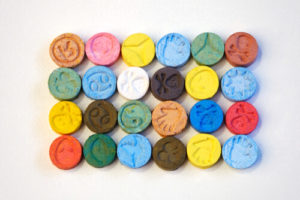This drug was initially developed in 1912 in Germany, intended to work as a prescription appetite suppressant, like other amphetamine-based drugs. In 1914, Merck Pharmaceuticals patented the drug and made it available for prescription in the United States. It was not widely popular, however, until the 1970s, when it was picked up by psychotherapists in the United States as a medication that could be used in small doses during psychotherapy sessions.
The drug began to be widely abused in larger doses for its euphoric high, increased physical energy, and tactile hallucinations. By 1988, the U.S. Drug Enforcement Administration (DEA) recategorized it as a Schedule I substance, meaning it has no medical use and is only a dangerous intoxicant.
By the time the DEA banned the drug, it had become a popular drug at nightclubs and dance parties, particularly among wealthier patrons. In 1984, the San Francisco Chronicle called ecstasy “the yuppie psychedelic,” since it was allegedly a milder and less dangerous hallucinogen than LSD. Ecstasy, Molly, and MDMA are all still associated with this culture today. It may also be abused in smaller settings, such as house parties or at get-togethers held on college campuses.
The ecstasy version of MDMA, which became infamous in the 1990s, has been heavily criticized for being diluted or adulterated with other substances, including dangerous drugs like ketamine, bath salts, or caffeine. Ecstasy abuse declined through the early 2000s, but Molly, the powdered crystalline form of MDMA, has retained a reputation for being “purer,” although this is not usually the case. The drug is highly addictive and dangerous.
MDMA Abuse

A Global Drug Survey from 2014 found that more than 20 percent of Americans had taken some form of MDMA at least once in the past year. A separate survey found that 1 percent of young adults in the U.S., between the ages of 19 and 28, had taken a form of MDMA at least once in the past month.
The National Survey on Drug Use and Health (NSDUH) for 2014 found that about 17 million people in the U.S., age 12 and older, tried MDMA at least once in their lifetimes; this is an increase from 2004, when 11 million people reported that they had tried this drug. The NSDUH also found that the number of people who abused MDMA in the past month was about 660,000, which was up from 450,000 in the previous decade.
In 2011, a report from the Drug Abuse Warning Network (DAWN) found that hospitalizations for acute problems involving MDMA rose to 22,498, or about 1.8 percent of all ER admissions. Most of this group admitted to the ER were between the ages of 18 and 20.
In 2015, around 3,510 people sought help from addiction treatment programs because of compulsive behaviors around MDMA.
For the most part, MDMA, ecstasy, and Molly are abused in the U.S. and western Europe. Much of the MDMA seized by law enforcement in the U.S. comes from Canada. To a lesser extent, MDMA smuggled into the U.S. comes from the Netherlands, but that nation typically sends more of their MDMA throughout Europe.
Chemical Changes in the Brain
MDMA is related to amphetamines and methamphetamine, in the phenethylamine family, so it has stimulant properties like raising internal temperature and creating a sense of intense euphoria and well-being. However, the drug also causes some hallucinations, including visual distortions and tactile hallucinations. These are typically described as being pleasant, but they may become uncomfortable.
For the most part, ecstasy, MDMA, and Molly are ingested orally. Ecstasy is most often found in tablet form, while Molly may be found in powdered form and mixed with water, juice, or alcohol. MDMA may also be found as a pill or capsule. It is rarely smoked or injected, although these forms of ingestion have occasionally occurred.
When consumed orally, MDMA takes about 15 minutes to fully affect the brain, and the effects last for 3 to 6 hours; peak effects hit within 60 to 90 minutes. Between 15 and 40 minutes after taking the drug, you will feel exhilarated and then nauseated.
MDMA releases serotonin, a mood-elevating neurotransmitter that is also associated with the brain’s reward system, sleep regulation, and heart rate. This drug forces a flood of serotonin into the brain, causing heightened sensitivity to physical sensations. It also causes the person to feel very emotional, usually in a pleasurable way, and very empathetic toward others. People who take MDMA report feeling more trusting, physically and sexually aroused, and loving of everyone around them.
Unfortunately, the physical effects while high on ecstasy can be dangerous. Hyperthermia, tachycardia or cardiac failure, seizures, and death from dehydration are all risks. Once the drug leaves the brain, the amount of available serotonin plummets, leaving you feeling depressed and fatigued. Many people who have abused MDMA report feeling “cracked out,” “burned out,” or drained for up to two days after taking it.
Symptoms of Intoxication and Withdrawal From Mdma
People who take MDMA seek the mental and emotional high associated with the drug, which may manifest as the following:
- Heightened senses
- Hallucinations, especially tactile sensations
- Feeling good
- Heightened empathy
- Emotional warmth
- Anxiety or paranoia
- Mental and physical relaxation
- Increased energy
- Restlessness
The Short-Term Physical Effects, Which Can Be Damaging, Include:
- Muscle tension
- Teeth grinding or jaw clenching
- Nausea and vomiting
- Heat exhaustion from high internal body temperature (up to 106 degrees Fahrenheit)
- Rapid heartbeat
- High blood pressure
- Faster, shallower breathing
- Feeling faint
- Sweating and becoming dehydrated
- Chills, like having the flu
- Blurry or double vision
- Impulsiveness
Once the effects of MDMA wear off, you will experience comedown symptoms. Among those are:
- Confusion
- Exhaustion
- Depression
- Sleep disturbances, including sleeping too much, not enough, or interrupted sleep
- Cravings for the drug
- Anxiety
- Paranoia
- Memory loss
MDMA Use Can Be Life-Threatening
MDMA may be a “feel-good” drug, but it can easily become a dangerous substance and cause death or physical harm. Because the drug elicits feelings of trust and empathy, it has sometimes been used as a date rape drug. When combined with alcohol, this potent mixture can lead to blackouts or memory trouble, making a report of an assault more difficult.
Adulterants found in MDMA can be extremely harmful, increasing the risk of death due to an overdose on multiple substances.
The Most Frequently Found Adulterants Are:
- Amphetamine
- Meth
- Cocaine
- Ephedrine
- Ketamine
- Synthetic cathinones, most notoriously bath salts and flakka
By themselves, these drugs are dangerous. When mixed with other stimulants or hallucinogens, MDMA and the above drugs may combine to cause a heart attack, seizure, respiratory depression, or sudden death.
Hyperthermia is also a risk from taking MDMA. Molly elevates the body’s internal temperature from a normal level to more than 100 degrees Fahrenheit, leading to dangerous consequences. When the temperature is more than 106 degrees, the body begins to shut down. There are specific symptoms of hyperthermia, sometimes called heat stroke. Other symptoms include:
- Confusion or delirium
- Aggressiveness
- Strong, rapid pulse
- No sweat even though the skin is very hot
- Dry, flushed skin
- Staggering
- Feeling or appearing faint
- Coma
Dehydration is also associated with MDMA, and it was involved in many hospitalizations and deaths when ecstasy became a popular club drug. The process involves a significant loss of water from the body, usually with a loss of sodium or other salts. Even low levels of dehydration in a sober individual can lead to lethargy, headaches, mood swings, and constipation. Severe dehydration occurs when 10 to 15 percent of the body’s water is lost, leading to some serious symptoms.
- Lack of sweating
- Shriveled, dry skin
- Sunken eyes
- Low blood pressure
- Rapid heart rate
- Fever
- Delirium and confusion
- Falling unconscious
If untreated, severe dehydration can also cause low blood volume, kidney damage and failure, heat injury, and seizures. These can be deadly.
Long-Term Abuse Damages the Brain
Animal studies involving consistent MDMA use show that using the drug frequently, at high doses, or for a long time may damage brain cells. It is hard to say for certain if MDMA is addictive, according to the medical definition of the term; however, some people who take it develop compulsive behaviors and escalate their use and abuse of the substance regularly, all of which indicate that they may struggle with addiction to ecstasy.
Regular abuse of MDMA also appears to change how the brain produces and responds to serotonin, and it changes the dopamine system, which is tied to the brain’s reward pathways. This can increase impulsive behaviors, including compulsions around drugs or alcohol. It increases the risk of mood disorders such as depression and anxiety, which, in turn, increases the risk of self-medicating with drugs and alcohol.
One of the comedown symptoms associated with abuse of this chemical is a craving for more because the brain has less serotonin than before the drug was taken. For some people, this may lead to a spiral of taking too much, indicating addiction. Brain damage, particularly to memory centers, is also a risk.
Treatment of MDMA addiction or serious long-term abuse of the drug primarily involves behavioral therapy. There are no substances prescribed to ease withdrawal symptoms, as there are for other drugs like opioids, but working with a medical team in a detox program to understand and manage your withdrawal symptoms helps you stay safe and avoid relapse. After that, entering rehabilitation means you have access to evidence-based counseling, especially cognitive behavioral therapy, to manage cravings and compulsive behaviors around the drug.
Related pages
(October 29, 2013). Ecstasy. Center for Substance Abuse Research. Retrieved December 2018 from http://www.cesar.umd.edu/cesar/drugs/ecstasy.asp
(2017). Ecstasy/MDMA: Drugs of Abuse, A DEA Resource Guide, 2017 Edition. U.S. Department of Justice (DOJ), Drug Enforcement Administration (DEA). Retrieved December 2018 from https://www.dea.gov/sites/default/files/sites/getsmartaboutdrugs.com/files/publications/DoA_2017Ed_Updated_6.16.17.pdf#page=66
(May 31, 2017). MDMA. History Channel, A&E Television Networks. Retrieved December 2018 from https://www.history.com/topics/crime/history-of-mdma
(June 29, 2017). MDMA: What You Need to Know About Molly. MedicalNewsToday.com. Retrieved December 2018 from https://www.medicalnewstoday.com/articles/297064.php
(September 2017). What is the Scope of MDMA Use in the United States? National Institute on Drug Abuse (NIDA). Retrieved December 2018 from https://www.drugabuse.gov/publications/research-reports/mdma-ecstasy-abuse/what-is-the-scope-of-mdma-use-in-the-united-states
(September 2017). What is MDMA? National Institute on Drug Abuse (NIDA). Retrieved December 2018 from https://www.drugabuse.gov/publications/research-reports/mdma-ecstasy-abuse/what-mdma
(January 8, 2015). Methylenedioxymethamphetamine (MDMA or “Ecstasy”) Drug Profile. European Monitoring Centre for Drugs and Drug Addiction (EMCDDA). Retrieved December 2018 from http://www.emcdda.europa.eu/publications/drug-profiles/mdma
(March 2017). MDMA (ecstasy). HealthDirect.gov.au. Retrieved December 2018 from https://www.healthdirect.gov.au/mdma-ecstasy
(July 27, 2012). Hyperthermia: Too Hot for Your Health. National Institutes of Health (NIH). Retrieved December 2018 from https://www.nih.gov/news-events/news-releases/hyperthermia-too-hot-your-health-1
(December 20, 2017). What You Should Know About Dehydration. Medical News Today. Retrieved December 2018 from https://www.medicalnewstoday.com/articles/153363.php
(September 2017). Is MDMA Addictive? National Institute on Drug Abuse (NIDA). Retrieved December 2018 from https://www.drugabuse.gov/publications/research-reports/mdma-ecstasy-abuse/mdma-addictive
(September 2017). How are MDMA Use Disorders Treated? National Institute on Drug Abuse (NIDA). Retrieved December 2018 from https://www.drugabuse.gov/publications/research-reports/mdma-ecstasy-abuse/how-are-mdma-use-disorders-treated


